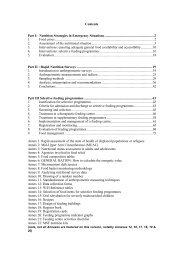UNHCR Handbook for Emergencies - UNHCR eCentre
UNHCR Handbook for Emergencies - UNHCR eCentre
UNHCR Handbook for Emergencies - UNHCR eCentre
Create successful ePaper yourself
Turn your PDF publications into a flip-book with our unique Google optimized e-Paper software.
160<br />
Monitoring and Surveillance: The Health<br />
In<strong>for</strong>mation System<br />
9. From the earliest stages of an emergency,<br />
a health in<strong>for</strong>mation system should be put in<br />
place under the responsibility of the <strong>UNHCR</strong><br />
Health Coordinator. The health in<strong>for</strong>mation<br />
system should be simple, reliable, and action<br />
oriented, and its use will be essential to:<br />
i. Quantify the health and nutritional status<br />
of the refugee population;<br />
ii. Follow trends in health status and monitor<br />
the impact and outcomes of the relief programme;<br />
iii. Detect epidemics;<br />
iv. Evaluate programme effectiveness and<br />
service coverage;<br />
v. Ensure that resources are targeted to the<br />
areas of greatest needs;<br />
vi. Re-orient the programme as necessary.<br />
10. Annex 1 sets out the tables and <strong>for</strong>ms <strong>for</strong><br />
collecting health-related in<strong>for</strong>mation. However,<br />
to have a more comprehensive idea of<br />
the situation, in<strong>for</strong>mation regarding water,<br />
food, sanitation, shelter and availability of<br />
soap should also be collected and analyzed<br />
(see the relevant chapters on water, nutrition,<br />
sanitation, and physical planning).<br />
11. The health in<strong>for</strong>mation system should be<br />
kept simple. The in<strong>for</strong>mation to be collected<br />
should be adapted to suit the collectors’ qualifications.<br />
Overly detailed or complex reporting<br />
requirements will result in non-compliance. In<br />
addition, only data that can and will be acted<br />
on should be collected. Communication and<br />
exchange of views among all the actors in the<br />
health in<strong>for</strong>mation system are essential to<br />
secure the functioning of the system.<br />
Only simple arrangements are effective in<br />
emergencies.<br />
12. Health in<strong>for</strong>mation in the initial stages<br />
of an emergency should concentrate on:<br />
i. Demography (see chapter 11 on registration,<br />
also paragraph 4 above, and table 1<br />
of Annex 1);<br />
ii. Mortality and its causes (see tables 2.1 and<br />
2.2 of Annex 1 and paragraph 14 below);<br />
iii. Nutritional status (see Annexes 4 and 5 of<br />
chapter 15 on food and nutrition);<br />
iv. Morbidity (see below, and table 3.1 of<br />
Annex 1).<br />
13. Only when the situation stabilizes can<br />
the system be made more comprehensive. In<strong>for</strong>mation<br />
on mortality and morbidity should<br />
be collected as follows:<br />
Mortality<br />
14. Each health facility should keep a log<br />
of all patient deaths with cause of death and<br />
relevant demographic in<strong>for</strong>mation. This in<strong>for</strong>mation<br />
should be summarized in tables 2.1<br />
and 2.2 of Annex 1, reported centrally and<br />
consolidated with other data. Because many<br />
deaths occur outside the health-care system, a<br />
community-based mortality surveillance system<br />
should also be established. Such a system requires<br />
identifying sites which people are using<br />
as cemeteries, employing grave watchers on a<br />
24 hours basis, routinely issuing burial<br />
shrouds, and using community in<strong>for</strong>mants.<br />
Deaths that occur outside hospitals with unknown<br />
causes should be validated through<br />
verbal autopsy by health workers specifically<br />
trained <strong>for</strong> this task.<br />
Morbidity<br />
15. Each health facility providing out-patient<br />
services (including clinics <strong>for</strong> under five’s and<br />
selective feeding programmes) should keep<br />
daily records. These records should be in the<br />
<strong>for</strong>m of a log book or tally sheets at least, and<br />
should at least record the patient’s name, age,<br />
sex, clinical and laboratory diagnosis and<br />
treatment. This in<strong>for</strong>mation should be summarized<br />
in the <strong>for</strong>ms set out as tables 3.1. in<br />
Annex 1 and reported centrally.<br />
16. Diseases recorded in the health in<strong>for</strong>mation<br />
system must have a case definition (i.e. a<br />
standard description) which will guide health<br />
workers in their diagnosis and ensure the consistency<br />
and validity of data. Where possible,<br />
case definitions that rely on clinical signs and<br />
symptoms (e.g. malaria) should be checked<br />
against a laboratory standard test (e.g. blood<br />
test <strong>for</strong> malaria).<br />
17. In addition, the patient should be issued<br />
a health record card (or “Road to Health”<br />
card) on which the date, diagnosis, and treatment<br />
are recorded. Every contact a patient has<br />
with the health-care system, whether <strong>for</strong> curative<br />
or preventive services, should be noted on<br />
the health record card retained by the patient.<br />
18. The health in<strong>for</strong>mation system should be<br />
periodically assessed to determine its accuracy,<br />
completeness, simplicity, flexibility, and timeliness.<br />
The way programme planners and key



